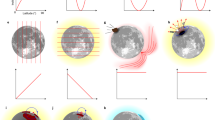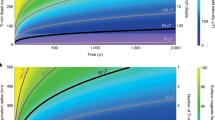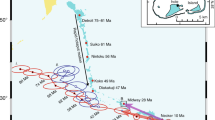Abstract
Reversals of the Earth's magnetic field reflect changes in the geodynamo—flow within the outer core—that generates the field. Constraining core processes or mantle properties that induce or modulate reversals requires knowing the timing and morphology of field changes that precede and accompany these reversals1,2,3,4. But the short duration of transitional field states and fragmentary nature of even the best palaeomagnetic records make it difficult to provide a timeline for the reversal process1,5. 40Ar/39Ar dating of lavas on Tahiti, long thought to record the primary part of the most recent ‘Matuyama–Brunhes’ reversal, gives an age of 795 ± 7 kyr, indistinguishable from that of lavas in Chile and La Palma that record a transition in the Earth's magnetic field, but older than the accepted age for the reversal. Only the ‘transitional’ lavas on Maui and one from La Palma (dated at 776 ± 2 kyr), agree with the astronomical age for the reversal. Here we propose that the older lavas record the onset of a geodynamo process, which only on occasion would result in polarity change. This initial instability, associated with the first of two decreases in field intensity, began ∼18 kyr before the actual polarity switch. These data support the claim6 that complete reversals require a significant period for magnetic flux to escape from the solid inner core and sufficiently weaken its stabilizing effect7.
This is a preview of subscription content, access via your institution
Access options
Subscribe to this journal
Receive 51 print issues and online access
$199.00 per year
only $3.90 per issue
Buy this article
- Purchase on Springer Link
- Instant access to full article PDF
Prices may be subject to local taxes which are calculated during checkout



Similar content being viewed by others
References
Merrill, R. T. & McFadden, P. T. Geomagnetic polarity transitions. Rev. Geophys. 37, 201–226 (1999)
Laj, C., Mazaud, A., Weeks, R., Fuller, M. & Herrero-Bervera, E. Geomagnetic reversal paths. Nature 351, 447 (1991)
Glatzmaier, G. A., Coe, R. S., Hongre, L. & Roberts, P. H. The role of the Earth's mantle in controlling the frequency of geomagnetic reversals. Nature 401, 885–890 (1999)
Hoffman, K. A. Dipolar reversal states of the geomagnetic field and core-mantle dynamics. Nature 359, 789–794 (1992)
Coe, R. S. & Glen, J. M. G. The complexity of reversals. In Timescales of the Paleomagnetic Field (eds Channell, J. E. T., Kent, D. V., Lowrie, W. & Meert, J.) 221–232 (Am. Geophys. Un. Geophys. Monogr. 145, 2004)
Gubbins, D. The distinction between geomagnetic excursions and reversals. Geophys. J. Int. 137, F1–F3 (1999)
Hollerbach, R. & Jones, C. A. Influence of the Earth's inner core on geomagnetic fluctuations and reversals. Nature 365, 541–543 (1993)
Laj, C., Guitton, S. & Kissel, C. Rapid changes and near-stationarity of the geomagnetic field during a polarity reversal. Nature 330, 145–148 (1987)
Channell, J. E. T. & Lehman, B. The last two geomagnetic polarity reversals recorded in high-deposition-rate sediment drifts. Nature 389, 712–715 (1997)
Kent, D. V. & Schneider, D. A. Correlation of paleointensity variation records in the Brunhes-Matuyama polarity transition interval. Earth Planet. Sci. Lett. 129, 135–144 (1995)
Channell, J. E. T. & Kleiven, H. F. Geomagnetic palaeointensities and astrochronologic ages for the Matuyama-Brunhes boundary and the boundaries of the Jaramillo Subchron: palaeomagnetic and oxygen isotope records from ODP site 983. Phil. Trans. R. Soc. Lond. A 358, 1027–1047 (2000)
Shackleton, N. J., Berger, A. & Peltier, W. R. An alternative astronomical calibration of the lower Pleistocene timescale based on ODP site 677. Trans. R. Soc. Edinb. Earth Sci. 81, 251–261 (1990)
Clement, B. Dependence of the duration of geomagnetic polarity reversal on site latitude. Nature 428, 637–640 (2004)
Hoffman, K. A. Transitional field behavior from southern hemisphere lavas: evidence for two-stage reversals of the geodynamo. Nature 320, 228–232 (1986)
Singer, B. S., Hoffman, K. A., Chauvin, A., Coe, R. S. & Pringle, M. S. Dating transitionally magnetized lavas of the late Matuyama Chron: Toward a new 40Ar/39Ar timescale of reversals and events. J. Geophys. Res. 104, 679–693 (1999)
Singer, B. S. et al. Ar/Ar ages of transitionally magnetized lavas on La Palma, Canary Islands, and the Geomagnetic Instability Timescale. J. Geophys. Res. Solid Earth 107(B11), doi:10.1029/2001JB001613 (2002)
Coe, R. S., Singer, B. S., Pringle, M. S. & Zhao, X. Matuyama-Brunhes reversal and Kamikatsura event on Maui: paleomagnetic directions, 40Ar/39Ar ages and implications. Earth Planet. Sci. Lett. 222, 667–684 (2004)
Brown, L., Singer, B. S., Pickens, J. & Jicha, B. Paleomagnetic directions and 40Ar/39Ar ages from the Tatara-San Pedro volcanic complex, Chilean Andes: Lava record of a Matuyama-Brunhes precursor? J. Geophys. Res. Solid Earth 109(B12), doi:10.1029/2004JB003007 (2004)
Love, J. J. & Mazaud, A. A database for the Matuyama-Brunhes magnetic reversal. Phys. Earth Planet. Inter. 103, 207–245 (1997)
Chauvin, A., Roperch, P. & Duncan, R. A. Records of geomagnetic reversals from volcanic islands of French Polynesia 2. Paleomagnetic study of a flow sequence (1.2 to 0.6 Ma) from the Island of Tahiti and discussion of reversal models. J. Geophys. Res. 95, 2727–2752 (1990)
Singer, B. S. & Pringle, M. S. Age and duration of the Matuyama-Brunhes geomagnetic polarity transition from 40Ar/39Ar incremental heating analyses of lavas. Earth Planet. Sci. Lett. 139, 47–61 (1996)
Brown, L., Pickens, J. & Singer, B. Matuyama-Brunhes transition recorded in lava flows of the Chilean Andes: Evidence for dipolar fields during reversals. Geology 22, 299–302 (1994)
Renne, P. R. et al. Intercalibration of standards, absolute ages and uncertainties in 40Ar/39Ar dating. Chem. Geol. 145, 117–152 (1998)
Tauxe, L., Herbert, T., Shackleton, N. J. & Kok, Y. S. Astronomical calibration of the Matuyama-Brunhes boundary: Consequences for magnetic remanence acquisition in marine carbonates and the Asian loess sequences. Earth Planet. Sci. Lett. 140, 133–146 (1996)
Hartl, P. & Tauxe, L. A precursor to the Matuyama/Brunhes transition-field instability as recorded in pelagic sediments. Earth Planet. Sci. Lett. 138, 121–135 (1996)
Prévot, M., Mankinen, E. A., Gromme, C. S. & Coe, R. S. How the geomagnetic field vector reverses polarity. Nature 316, 230–234 (1985)
Hoffman, K. A. & Singer, B. S. Regionally recurrent paleomagnetic transitional fields and mantle proccesses. in Timescales of the Paleomagnetic Field (eds Channell, J. E. T., Kent, D. V., Lowrie, W. & Meert, J.) 223–243 (Am. Geophys. Un. Geophys. Monogr. 145, 2004)
Clement, B. M. & Kent, D. V. Geomagnetic polarity transition records from five hydraulic piston cores sites in the North Atlantic. In Init. Rep. Deep Sea Drilling Project (eds Ruddiman, W. F. et al.) 94, 831–852 (US Government Printing Office, Washington, 1987)
Acknowledgements
We thank J. Pickens, M. Relle, A. Battle, L. Powell and R. Allen for assistance with field work, argon and palaeomagnetic analyses, and graphics. This study was supported by the US NSF.
Author information
Authors and Affiliations
Corresponding author
Ethics declarations
Competing interests
The authors declare that they have no competing financial interests.
Supplementary information
Supplementary Table S1
This file contains a spreadsheet with a single table of argon isotope data and age calculations. Complete 40Ar/39Ar Analyses of transitionally magnetized lava flows from Punaruu Valley, Tahiti. (PDF 20 kb)
Rights and permissions
About this article
Cite this article
Singer, B., Hoffman, K., Coe, R. et al. Structural and temporal requirements for geomagnetic field reversal deduced from lava flows. Nature 434, 633–636 (2005). https://doi.org/10.1038/nature03431
Received:
Accepted:
Issue Date:
DOI: https://doi.org/10.1038/nature03431
This article is cited by
-
Matuyama–Brunhes geomagnetic reversal record and associated key tephra layers in Boso Peninsula: extraction of primary magnetization of geomagnetic fields from mixed magnetic minerals of depositional, diagenesis, and weathering processes
Earth, Planets and Space (2022)
-
Intermittent non-axial dipolar-field dominance of twin Laschamp excursions
Communications Earth & Environment (2022)
-
A centennial-resolution terrestrial climatostratigraphy and Matuyama–Brunhes transition record from a loess sequence in China
Progress in Earth and Planetary Science (2020)
-
A full sequence of the Matuyama–Brunhes geomagnetic reversal in the Chiba composite section, Central Japan
Progress in Earth and Planetary Science (2020)
-
Timing of the Brunhes-Matuyama transition constrained by U-series disequilibrium
Scientific Reports (2019)
Comments
By submitting a comment you agree to abide by our Terms and Community Guidelines. If you find something abusive or that does not comply with our terms or guidelines please flag it as inappropriate.



